Table of Contents
The term contemporary has become such a household feature in every artistic occupation. Be in music, dance, artwork, photography, or anything that remotely signifies creativity with elegance, really. So why not interior design, right?
Today, let us discuss how contemporary interior design ideas can transform your contemporary home design into a haven for post-modernism and style. But before we delve into the detailed tips on how to renovate your house into a contemporary home, let us understand what this concept truly signifies.
Before we jump into the top contemporary design tips, however, let’s review some key information.
What is Contemporary Interior Design?
Since the late 1900s, when post-modernism was introduced into the art world, people began to favor this eclectic form of home design ideas. These art forms combined classic craftsmanship with modern design for a refreshing take on cultural dogmas. Interior designers, at the time, embraced this new design inspiration with gusto to bring together various time periods with style. When talking about modern contemporary interior design, do you often confuse the two styles? Let’s clear the modern vs contemporary haze for you.
Quick fact – The word ‘contemporary’ signifies ‘modern’, therefore, anything that can add a touch of modernism, easily translates to contemporary style. This sophisticated interior design style employs clean lines, minimalist trends, and neutral colors to express an innate need for form and function, forming the basis of many contemporary home decor ideas.
Modern contemporary interior design dictates that all forms of art deco and craftsmanship should serve a purpose, either to add functionality or aesthetic value to a contemporary home.
Artem Kropovinsky, founder and interior designer at Arsight, NYC, says, “For modern design, “less is more”. We strive for understatement by selecting only those pieces that have simple straight lines and minimalist impact on the environment.”
Contemporary vs. Modern Design: What’s the Difference?
When talking about modern contemporary interior design, do you often confuse the two styles? While the terms are often used interchangeably, they represent distinct concepts. Modern Design refers to a specific, static design movement from the early to mid-20th century, encompassing styles like Bauhaus and Mid-Century Modern.
Contemporary Design, on the other hand, is dynamic and ever-evolving. It reflects the trends of the here and now. While it often borrows elements from modernism, like clean lines and simplicity, it also incorporates new materials, technology, and other popular styles, making it a fluid representation of current tastes.
Here is a comparative analysis of both design approaches:
| Feature | Modern Design | Contemporary Design |
| Time Period | A specific historical era, roughly from the 1920s to the 1960s. | Fluid and evolving, representing the popular designs of the present day. |
| Color Palette | Emphasizes earthy tones, wood, and primary colors like red, blue, and yellow. | Based on a foundation of neutrals like black, white, and gray with bold accents. |
| Materials | Focuses on natural materials like wood, leather, and natural fibers. | Mixes natural materials with industrial elements like steel, concrete, and glass. |
| Furniture | Iconic pieces with exposed legs and clean forms | Varied styles with emphasis on comfort and function |
Read also – 30 Jargons and Other Popular Terms Used in Interior Designing
12 Contemporary Interior Design Ideas for Home
Ready to bring this elegant style into your own home? Here are 12 contemporary interior design ideas that focus on creating sophisticated, uncluttered, and highly functional living spaces.
1. Embrace Clean Lines and Minimalism
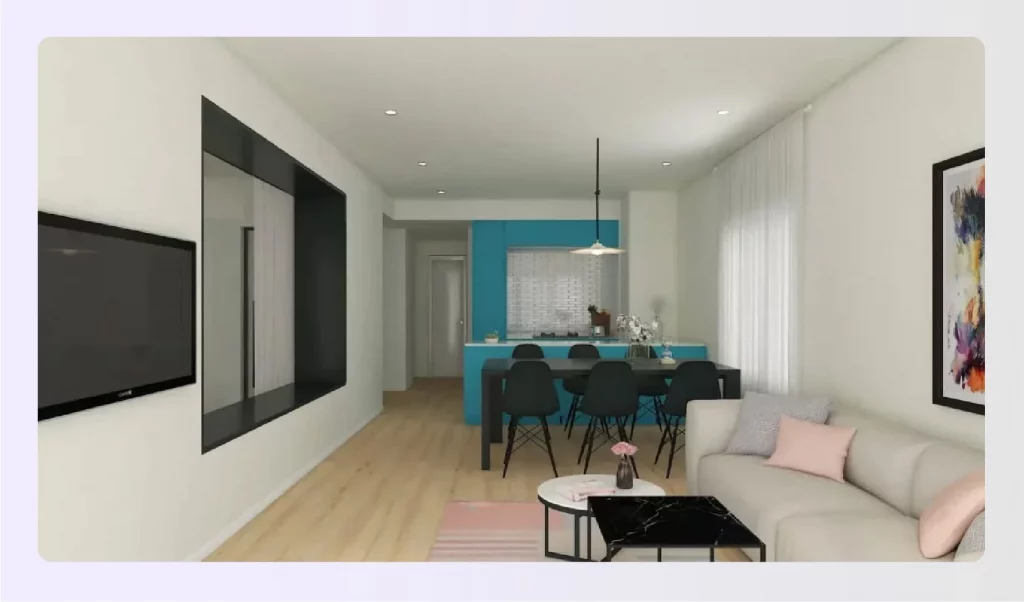
A minimalist approach is key to contemporary interior design
Clean lines are a hallmark of contemporary interior design, offering a no-fuss layout that contributes to a fresh and light atmosphere in a space. Minimalism emphasizes a less is more philosophy where every object serves a purpose, leading to uncluttered and efficient living environments. The use of a neutral color palette is intrinsic to minimalist design, allowing for the combination of different textures and organic shapes to enhance sophistication and warmth. Contemporary interiors prioritize open layouts that create the illusion of larger spaces, fostering free-flowing multifunctional areas devoid of excessive decor. Incorporating natural materials and subtle architecture with clean lines contributes to a timeless appeal that characterizes modern contemporary interior design.
Read also – Psychology of Colors in Interiror Design
2. Utilize a Neutral Color Palette with Bold Accents
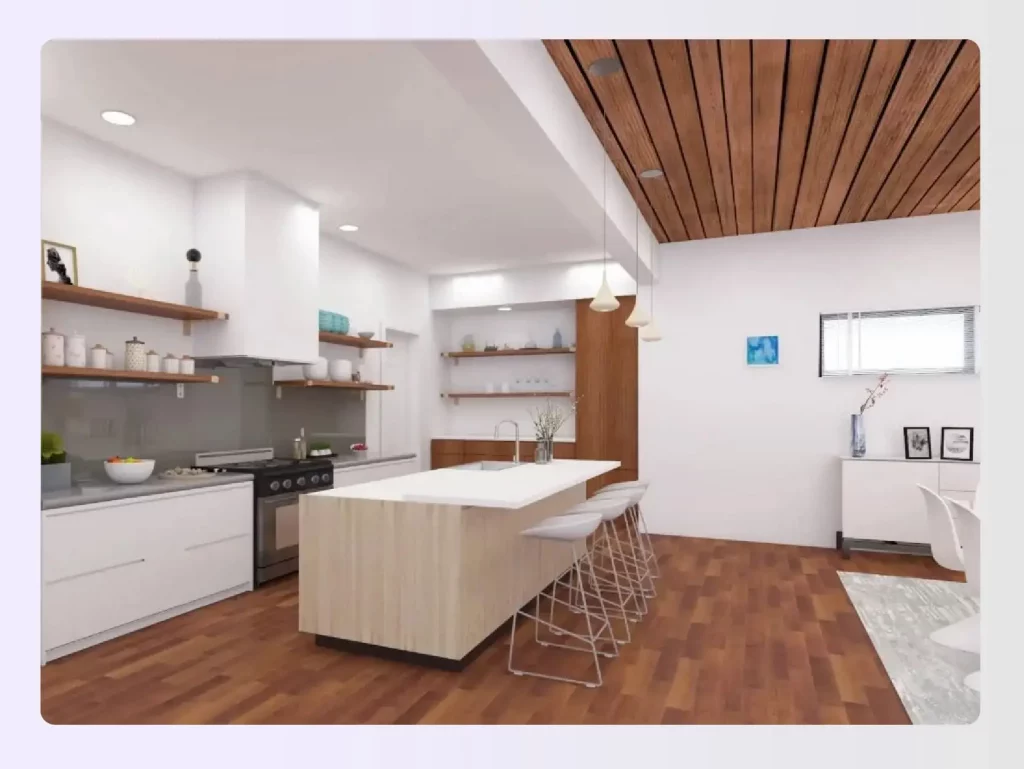
This contemporary home design uses a warm, neutral palette
A neutral color palette, including whites, beiges, and grays, creates a serene backdrop that enhances the overall elegance of contemporary home decor. Utilizing a neutral base in home decor allows for greater flexibility to introduce vibrant accents through decor items like artwork and textiles. Contemporary design often incorporates pops of color to personalize living spaces while maintaining a harmonious atmosphere with its neutral foundation. Incorporating statement rugs can help define areas in open-concept homes and serve as an opportunity to bring color and character to otherwise neutral spaces. Consumers are increasingly favoring creamy neutral tones, which offer versatility and warmth while fostering a calm environment in contemporary interiors.
Artem Kropovinsky, founder and interior designer at Arsight, NYC has an interesting point about textures in contemporary design. He notes that it is important to note that though the texture plays a silent role, it is among the crucial elements. We enjoy pitting textured accents against polished finishes for a more tactile feel.
Read also – Best Master Bathroom Design Ideas
3. Incorporate Natural Elements for Texture
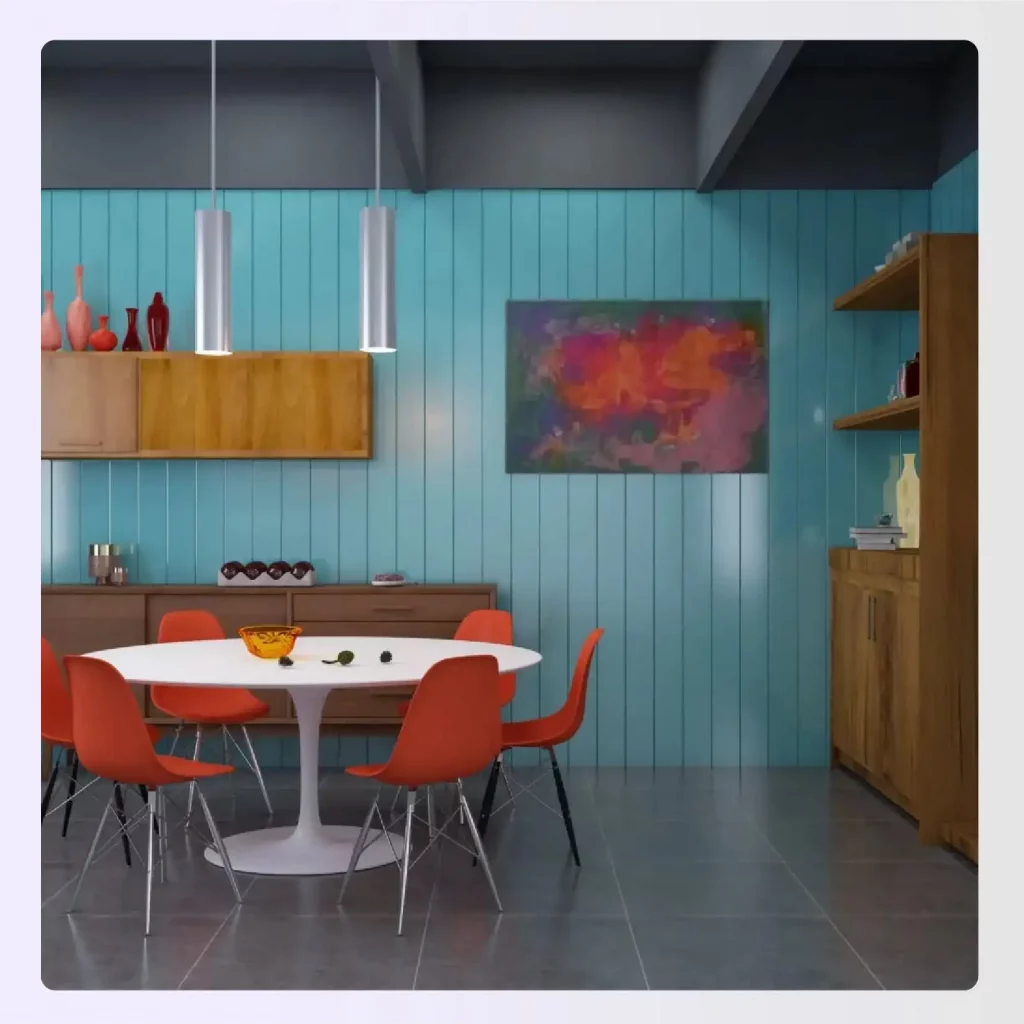
Incorporating natural materials adds warmth to your design
Incorporating organic materials such as plaster, clay, woven fibers, leather, iron, and wood can create a warm and welcoming atmosphere in your modern contemporary interior house design. The use of wooden tones in a minimalist space enhances visual contrast against neutral colors, making the area feel more inviting and cozier. Natural light plays a crucial role in contemporary homes by making open spaces appear more expansive and cleaner, contributing to a serene living environment. Mixing natural stone and white woods in design fosters a calming atmosphere that connects residents with their surroundings. Integrating natural elements and textures adds depth and dimension to each room, enriching the overall character of the home.
Read also – Modern Interior Design vs Contemporary Interior Design
4. Focus on Multifunctional Spaces

A great example of modern contemporary house interior design
Contemporary interior design emphasizes the creation of multifunctional spaces, which fosters a sense of flexibility and practicality in home layouts. Open layouts are crucial in contemporary design, as they promote free-flowing, multi-use areas while maintaining a sophisticated appearance. Incorporating multi-functional furniture pieces is a hallmark of contemporary design, ensuring that spaces remain stylish yet efficient for daily use. The design encourages uncluttered environments, which enhances the illusion of larger spaces, essential for maintaining an airy and inviting atmosphere. Embracing contemporary house design ideas involves integrating designs that adapt to various needs, enhancing the overall usability of a home space.
Read also – How To Become a Certified Interior Designer Without A Degree in 2025?
5. Choose Statement Lighting for Impact

Statement lighting can elevate your contemporary interior design style
Statement lighting is a key element in contemporary interior design, often featuring unique fixtures that serve as both functional and artistic focal points in a room. Modern homes tend to favor energy-efficient lighting solutions, ensuring well-lit spaces without excessive energy consumption. Architectural lighting, including sconces, chandeliers, and sculptural floor lamps, is becoming more prevalent, replacing purely functional lighting to add dimension and warmth. Layered lighting, incorporating task, accent, and ambient lighting, allows rooms to shift in mood throughout the day, enhancing the overall atmosphere of the space. The use of statement lighting fixtures can infuse a modern aesthetic into interiors, creating visual interest and contributing to the overall design appeal of the home.
Read also – Top 11 Residential Design Software for Interior Designers in 2024
6. Blend Different Styles for Personalization

Blending styles for personalized contemporary interior design ideas
Contemporary interior design allows for blending styles, offering flexibility in creating personalized spaces that reflect individual aesthetics. Incorporating elements from different design movements, such as Scandinavian simplicity and functionality, enhances contemporary interiors while maintaining a modern aesthetic. Using a neutral color palette as a base backdrop can compliment diverse decor choices, allowing for the inclusion of vibrant accents that can showcase personal style. A successful design approach involves mixing colors, textures, woods, and metals to create a comfortable and naturally lived-in atmosphere that reflects personal experiences. Emphasizing a cohesive palette while avoiding overly coordinated pieces fosters a unique character within a room, mixing items to achieve a sophisticated yet casual ambiance.
Artem, founder and interior designer at Arsight, NYC, drives home the importance of lighting in contemporary design. He observes, “Lighting is the backbone of interior decoration. Through a careful process of blending natural and artificial lighting, we create just the right ambiance while enhancing important features.”
Read also – Best Kitchen Lighting Ideas
7. Invest in Quality Craftsmanship
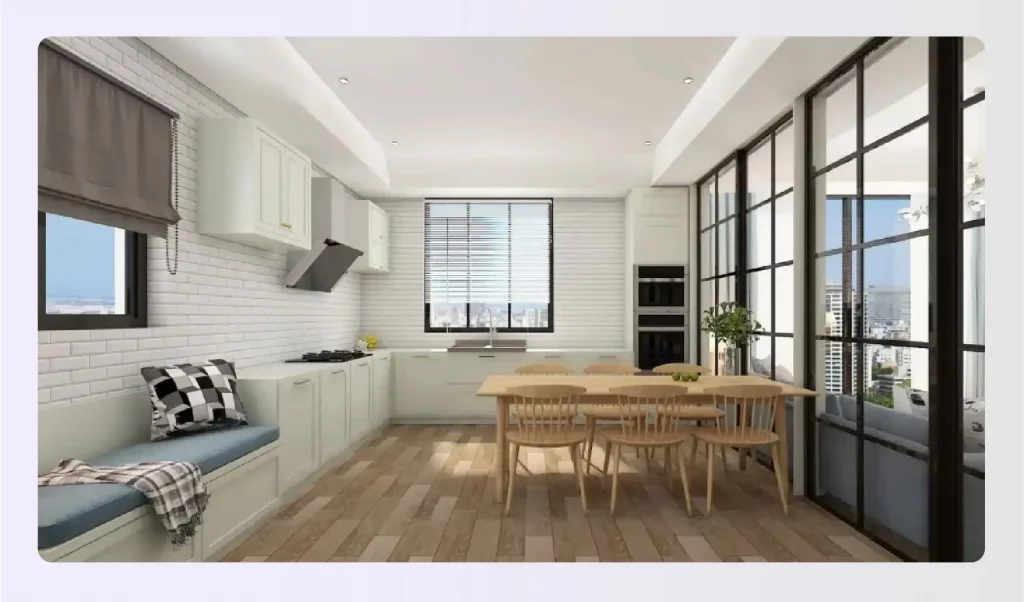
Quality craftsmanship is a cornerstone of great design
Investing in high-quality craftsmanship in contemporary furniture ensures both aesthetic appeal and durability, making these pieces worthwhile financial investments. Modern furniture should showcase artisanal quality and meticulous attention to detail to enhance the overall look of the interior space. Exquisite design elements can be incorporated into functional furniture pieces, provided they maintain a clean and defined structure. The demand for detailed craftsmanship is increasingly reflected in the resurgence of fabric drapes and shades, emphasizing their role as design features. Craftsmanship is a vital component of contemporary interior design, marrying functionality with artistic expression through well-designed pieces and thoughtful details.
Read also – Dining Room Decoration Ideas
8. Use Artwork as a Focal Point
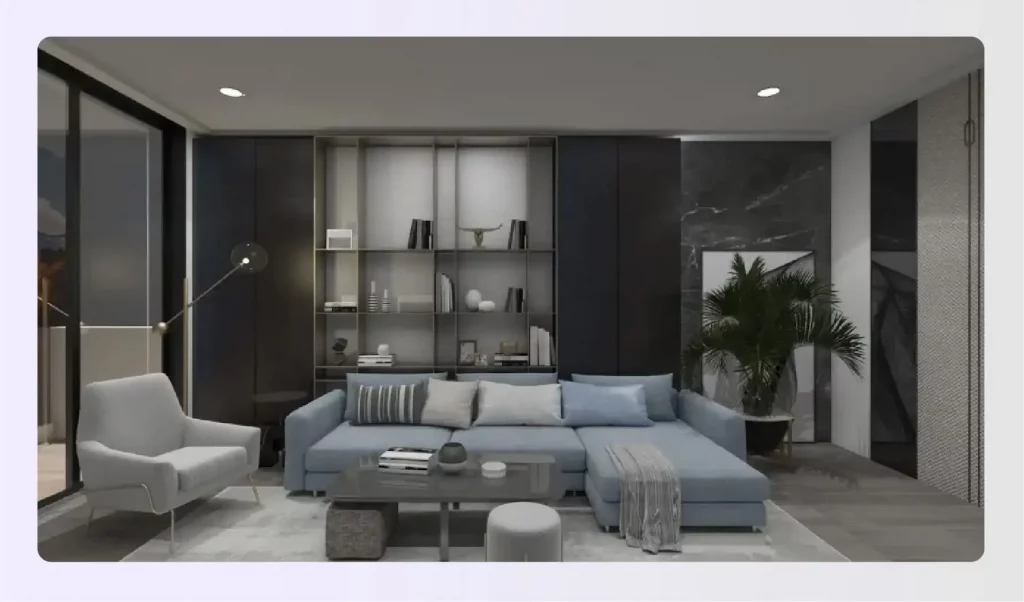
Using artwork as a focal point in your design
Contemporary design allows for individual expression through personal touches such as bold prints and expressive artwork, making the space unique and inviting. Statement lighting pieces can serve as focal points in a contemporary interior, adding both functionality and artistic expression to the room. Layering a smaller accent rug over a statement rug not only helps to define a room but also brings additional layers and textures that can complement artwork as a focal point. The use of a neutral palette in contemporary interiors emphasizes focal points, making elements like significant artwork stand out. In contemporary design, combining various aesthetics—such as an antique console alongside modern art—can create a captivating visual dynamic, with artwork serving as an essential focal point.
Read also – Small House Design Ideas
9. Create Open Floor Plans for Flow and Space
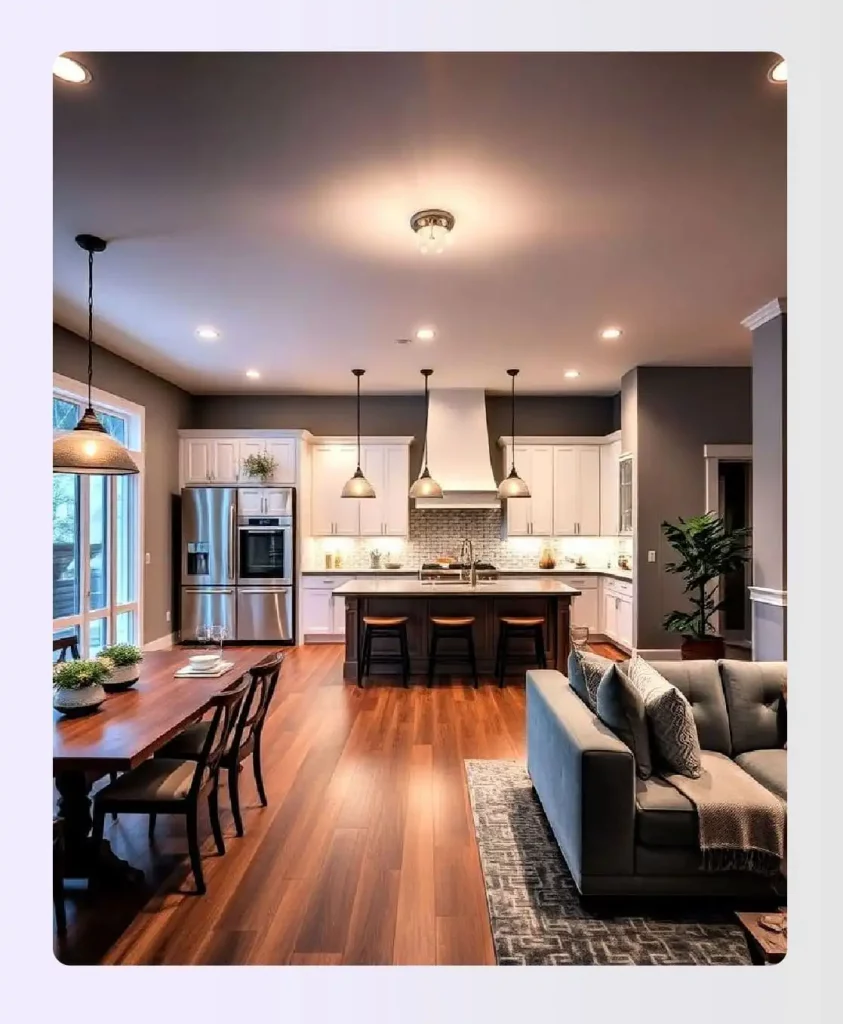
Contemporary open floor plan enhancing spatial flow and connectivity
Open floor plans contribute to a sense of openness, making spaces feel larger and more inviting. The use of large windows in open layouts brings in ample natural light, enhancing the overall brightness of the area. Architectural elements like glass doors are often featured in contemporary designs to create seamless transitions between spaces.
An open layout integrates kitchen, dining, and living areas, allowing for better flow and connectivity within the home. Maintaining a basic layout in open floor plans helps prevent the space from appearing cluttered or overly busy.
Artem founder and interior designer at Arsight, NYC agrees with functionality reigning supreme. He recommends designers go for multifunctional furnishings that are just as stylish as they are useful.
10. Incorporate Smart Home Technology
Smart home technology has become an integral component of contemporary interior design ideas. Modern homes increasingly feature integrated systems controlling lighting, temperature, security, and entertainment. These smart solutions not only enhance convenience but also contribute to energy efficiency and sustainability goals.
From voice-activated assistants to automated window treatments, technology is seamlessly blended into the aesthetic of contemporary spaces. The key is implementing these technological elements without compromising the clean, uncluttered look that defines contemporary design.
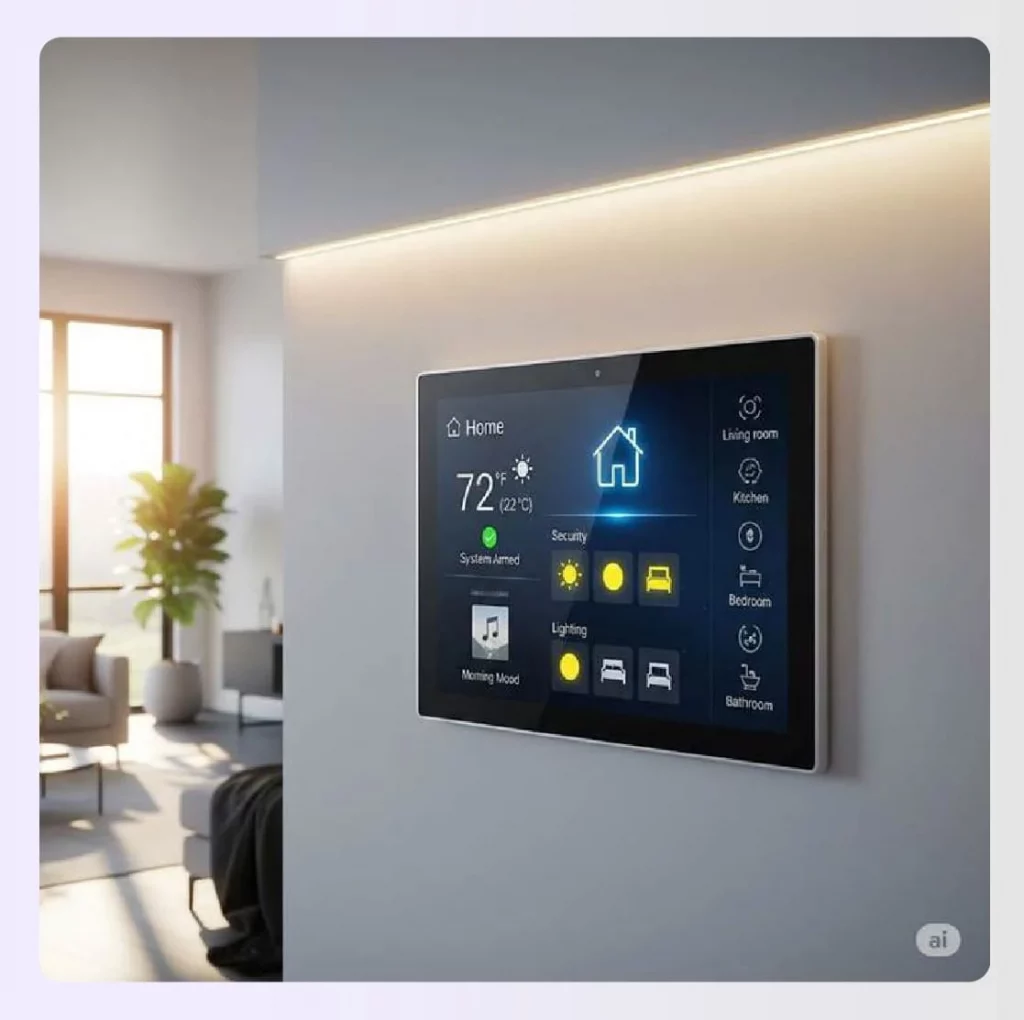
Smart technology integration in contemporary interior design
Image Credit: Pinterest
11. Use Large-Scale Art and Mirrors
In contemporary home design, oversized elements create dramatic impact and can transform ordinary spaces. Large-scale artwork serves as commanding focal points, while substantial mirrors not only make statements but also strategically reflect light to enhance spatial perception.
Contemporary spaces often feature floor-to-ceiling mirrors or groupings of oversized art pieces to create visual interest and depth. This approach emphasizes the contemporary preference for bold, impactful elements rather than numerous small decorative items, maintaining the clean, uncluttered aesthetic central to contemporary styling.
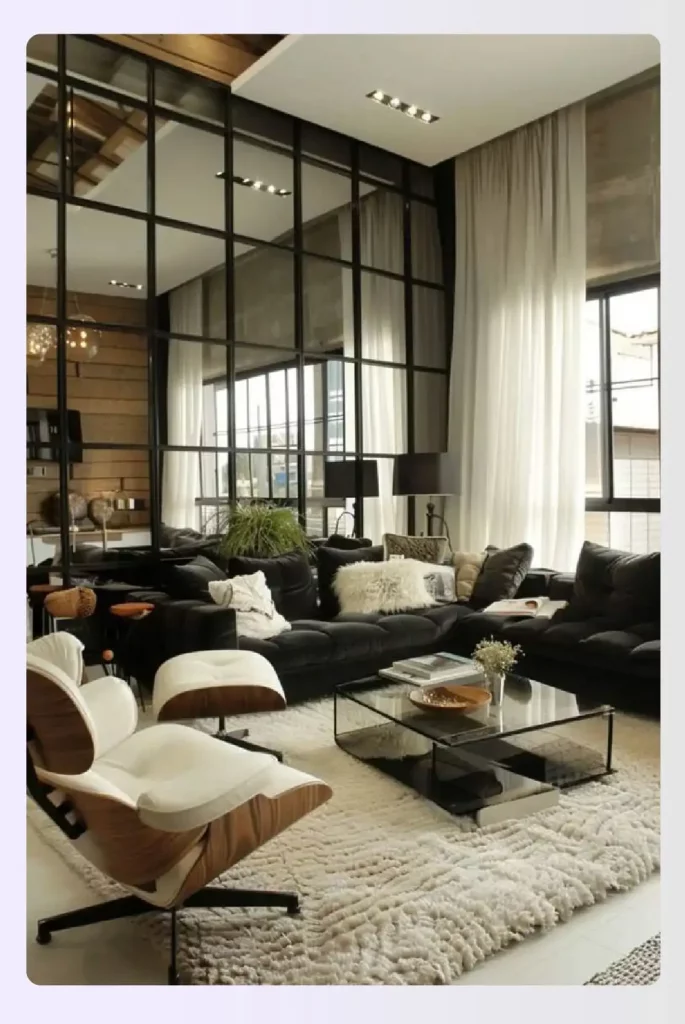
Oversized mirror enhancing contemporary interior design aesthetic
Image Credit: Pinterest
12. Embrace Curved and Organic Forms
While contemporary interior design ideas favor straight lines and angular shapes, current trends show increased incorporation of curved and organic forms. From rounded sofas and circular coffee tables to arched doorways, these softer elements introduce a sense of movement and fluidity to contemporary spaces.
The juxtaposition of curves against the predominant straight lines creates visual interest and softens the overall feel of the space. This trend represents the evolving nature of contemporary design, which continues to incorporate new elements while maintaining its essential characteristics of clean lines and uncluttered spaces.
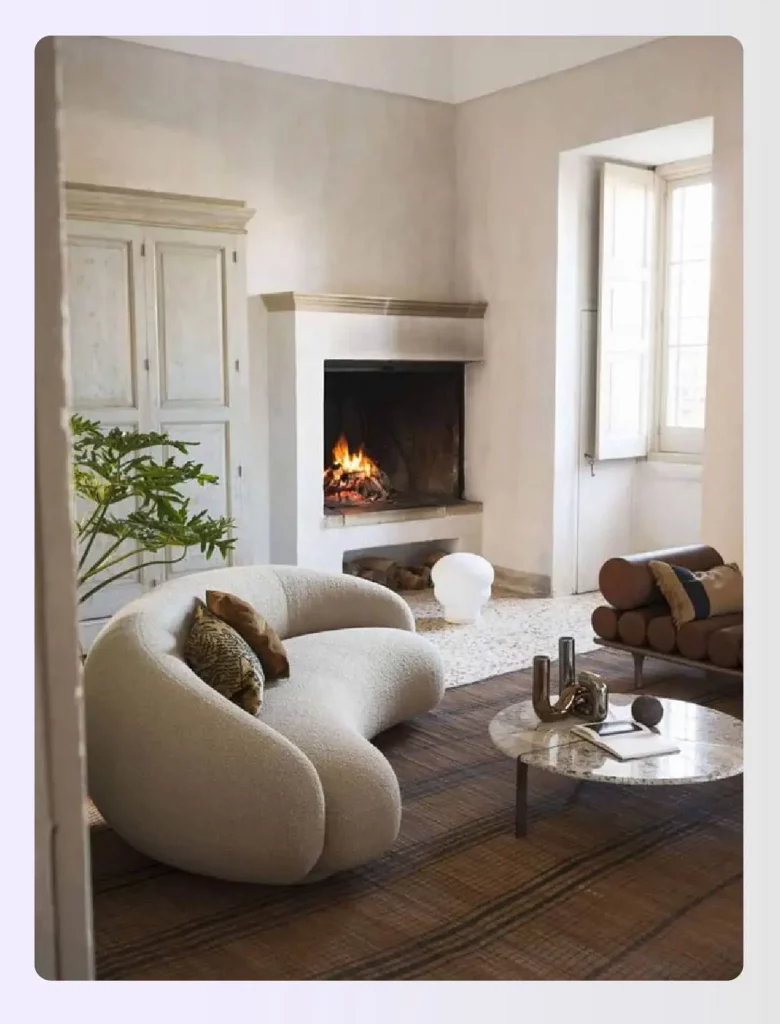
Contemporary living space featuring elegant curved furniture forms
Image Credit: Pinterest
Tips to Enhance Your Contemporary Interior Design Ideas
Let’s explore some tips to help you implement your contemporary interior design ideas seamlessly:
The Color Palette: Neutrals Reign Supreme
The foundation of contemporary interior design ideas begins with a carefully selected neutral palette. Think of shades of gray, white, black, and beige creating a clean and calm backdrop. This neutral canvas allows you to introduce bold, saturated accent colors for impact.
A single emerald green chair, a piece of art with a splash of navy, or burnt orange cushions on a sofa can add personality without overwhelming the space.
Form and Line: Keep it Clean and Crisp
Strong, clean lines are fundamental to the contemporary interior design style. Look for the emphasis on strong vertical and horizontal lines in both the architecture and furniture. Architectural details like high ceilings, bare windows that let in abundant light, and geometric shapes in wall art, rugs, or light fixtures reinforce this clean and crisp aesthetic.
The emphasis on clean lines doesn’t mean contemporary spaces feel rigid. Rather, the intentional use of strong, deliberate lines creates a framework that feels ordered and purposeful, allowing the occasional curved element to stand out dramatically.
Materials and Textures: A Tactile Experience
Contemporary interior design style masterfully blends natural and industrial materials to create spaces with depth and character. Wood, stone, and metal often appear side-by-side, creating interesting contrasts between warm and cool, soft and hard. This material mix prevents contemporary spaces from feeling cold or sterile.
Texture plays an equally important role in adding warmth and interest. Wool rugs, linen upholstery, cotton throws, and silk accent pillows introduce tactile elements that invite touch and create comfort.
Where Can You Introduce Contemporary Interior Design Ideas in Your Home
Let’s explore how you can implement these contemporary interior design ideas in your home:
a) Contemporary Bedroom
As we have already established, these contemporary interior design ideas focus on minimalism. Therefore, in order to transform your bedroom, start by discarding the mountain of decorative pillows and only keep the ones you need to sleep. Replace the contemporary rustic dresser and vanity with one that has clean lines and lots of storage space.
You can install a stage bed or a box bed that doesn’t attract a lot of clutter underneath. Use sheets, pillow covers, and linens with clean, geometric patterns or stick to white. You can never go wrong with white.
Read also – Modern Bedroom Designs Vs Contemporary Bedroom Designs
b) Contemporary Interior Design Living Room and Hall
Moving on to the living room, consider using some multifunctional furniture with glass or wooden textures. Use pastel, monochromatic colors as much as possible. You can also use some neutral colors for area rugs by embracing the Japanese culture of implementing jute mats, a staple in many modern home decor ideas. Install storage spaces in ideal locations in a contemporary living room and shoe racks and overhead cubbies in the hall to hide away all unnecessary items from view.
Read also – Best Living Room Ideas
c) Contemporary Kitchen and Dining Area
Finally, a contemporary kitchen, especially in small apartments in New York, can double as a dining room. Whether or not you have a separate space for it, consider room ideas that can be multifunctional.
Install some wooden and glass cabinetry in the kitchen and maybe a breakfront for your China in the dining room. You can also use shelving and drawers with rollers as they provide a modern feel when in use. Swap the wooden splashboard laminate with a tile backsplash, and while you’re at it, consider upgrading your appliances as well. Use simple, geometric dining mats, and consider replacing your dining furniture with polished wood designs.
Create Your Contemporary Interior Designs with Foyr
So there you have it. With these simple tips and tricks, you can quickly convert any living space using these contemporary interior design ideas. If you are still uncertain about how to remodel your beautiful house into a modern home, or unsure about which contemporary home decor ideas to choose, you can use Foyr to design a contemporary home on a 3D platform and check these contemporary interior design ideas in your floor plans before you implement them.
For these contemporary design inspirations (and more!), sign up for a free 14-day trial of Foyr today. No strings attached
Frequently Asked Questions (FAQs)
1. What are the trends in contemporary interior design?
Current contemporary interior design ideas and trends include multifunctional spaces, sustainable materials, and statement lighting fixtures. Curved furniture shapes are replacing rigid lines, while textured surfaces add depth to neutral palettes. Modern contemporary interior design embraces biophilic elements, bringing nature indoors through plants and natural materials. Smart home technology integration, mixed metals, and handcrafted artisanal pieces are becoming essential components of contemporary house design ideas.
2. What are the principles of contemporary interior design?
Contemporary interior design ideas follow key principles including clean lines, open spaces, and functional simplicity. Neutral color schemes serve as foundations while allowing bold accent pieces. Contemporary home decor emphasizes quality craftsmanship over quantity of objects. Balance between form and function guides all design decisions. Natural light maximization, thoughtful negative space usage, and architectural feature highlighting create cohesive, harmonious environments that feel both sophisticated and comfortable.
3. What are three characteristics of a contemporary design style?
Three key characteristics define the contemporary design style. First is a neutral color palette, using shades of white, gray, and beige as a calm backdrop. Second is the emphasis on clean lines and form, seen in simple, uncluttered furniture and architecture without heavy ornamentation. The third is the use of natural materials and texture, incorporating elements like wood, stone, metal, and linen to add warmth, depth, and character to the overall design.
4. What is soft contemporary interior design?
Soft contemporary interior design ideas blend the clean lines of contemporary style with warmer elements for increased comfort. This approach maintains minimalist principles while incorporating softer textures, rounded edges, and warmer color palettes. Contemporary house decor ideas in this style feature plush fabrics, layered textiles, and organic shapes that create inviting environments. The result balances modern aesthetics with homey comfort, creating spaces that feel sophisticated yet relaxed and livable.
5. How to design a contemporary house?
To design a contemporary house, start by creating an open floor plan to maximize space and light. Choose a neutral color palette for walls and large furnishings. Select furniture with clean lines and simple forms. Incorporate natural materials like wood and stone for texture and warmth. You can use Foyr Neo to visualize your contemporary house design ideas in 3D, helping you perfect the layout, material choices, and furniture placement before committing to the final design.
6. What does a contemporary room look like?
A contemporary room looks open, spacious, and uncluttered. It features a base of neutral colors on the walls, like white or gray, which makes the space feel bright and airy. The furniture has clean, straight lines and smooth surfaces with no elaborate details. You will notice a focus on texture through natural materials, such as a wooden floor or a metal light fixture. The room feels intentional, with each object having a purpose, often highlighted by a single piece of bold art.
7. How much does it cost to build a 1500 sq ft modern house?
The cost can vary significantly based on location, material quality, and labor rates. On average, it can range from $200,000 to over $500,000. Using a tool like Foyr Neo can help you plan your layout and select materials efficiently, allowing you to create a detailed budget and visualize costs before construction begins.
8. What are the colors for modern contemporary interior design?
The palette is primarily based on neutrals like white, gray, beige, and black, which create a clean backdrop. This foundation is then punctuated with bold, saturated accent colors for dramatic effect. Think of a pop of emerald green, deep navy, or vibrant orange used on a single piece of furniture or in artwork.
9. What is the difference between mid-century modern and contemporary?
Mid-century modern is a specific design style from the mid-20th century, characterized by organic shapes, wood tones, and a specific color palette. Contemporary design is what is popular right now and is constantly evolving. It often borrows from modernism’s simplicity but is not tied to a single historical period.









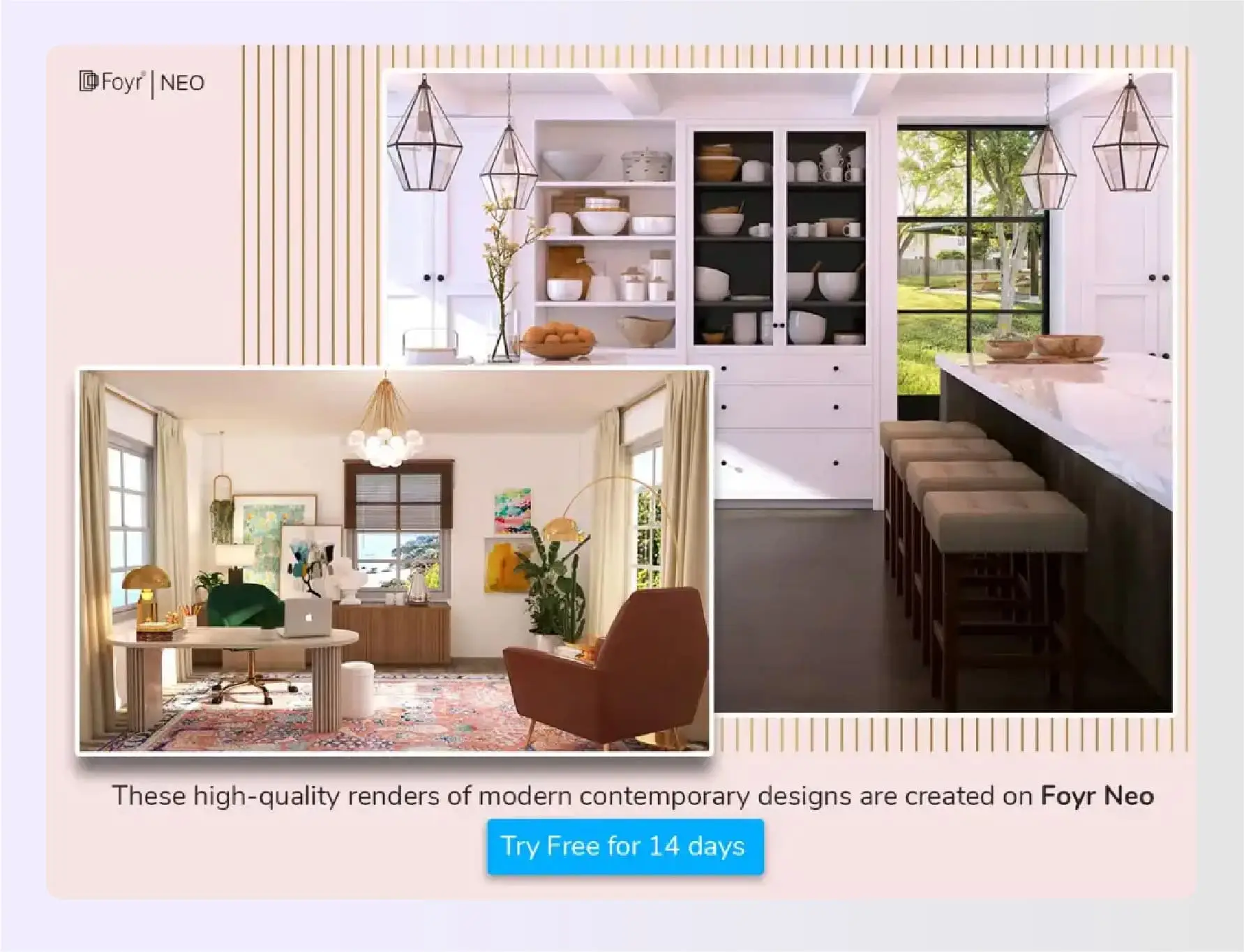
Leave A Reply